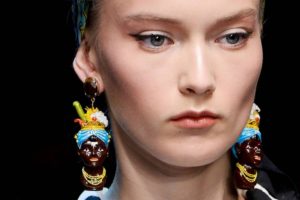
Join us for our weekly BAJ:Insight on the latest industry trends by Rachael Taylor, a freelance journalist who writes about jewellery for a number of titles, including The Financial Times, The Jewellery Editor and Retail Jeweller. In her 10 years reporting on the industry, she has travelled the globe to visit key industry fairs, descended a Fairtrade gold mine on top of a Peruvian mountain, toured silver jewellery factories in Thailand, and regularly has access to the most sparkling jewels and people in the business.
Princess Michael of Kent got into hot water over the festivities when she was accused of being racist by wearing a blackamoor brooch to a dinner that Prince Harry’s fiancé Meghan Markle, who is of mixed race, also attended. The jewel that caused so much outrage was a brooch pinned to her coat lapel depicting a man with dark skin dressed in a golden turban and jacket. A risqué choice in the current climate, perhaps, but blackamoor art has been prized by collectors since the 17th century.

Blackamoor is an art form that depicts highly decorative, exotic non-white figures, often bejewelled black African men. These figures, usually painted with gold leaf, appeared in homewares, with statues guarding doors in lieu of real servants, or men in eye-watering contortions proffering trays to be used as tables. They also appear in jewellery design, and were particularly popular in the workshops of Venice. This is a heritage that Italian fashion brand Dolce and Gabbana tried to pay homage to by including blackamoor earrings in its spring/summer 2013 show, though the decision attracted much criticism.

Once a symbol of exoticism and source of awe for the cloistered European masses fascinated with what they considered the more mysterious parts of the world, blackamoor jewellery is not as well-received today because of its negative associations with the slave trade. Though blackamoor figures are usually lavishly dressed, they are often in subservient positions or presented as curios rather than human beings. This being said, there are still countries where it remains popular. Croatia is one. Travel there and you will find that morcic – earrings and pendants decorated with blackamoor figures – are popular items for sale in local markets.
Blackamoor jewellery also still commands strong prices in the auction world despite the controversy. At Sotheby’s most recent jewellery sale in December, there were two blackamoor brooches very similar to that worn by Princess Margaret of Kent. The more expensive of the two, a carved black amber brooch decorated with gold, rubies, pearls and diamonds, signed by Venetian craftsman G. Nardi, sold for £5,000. The other, similar but less resplendent, sold for £1,875. This is proof enough that there remains a market for such designs despite the debate.
Only Princess Margaret of Kent, who is a serious long-term jewellery collector, knows her true intentions when she pinned that brooch on. Her statement after the festive dinner was clear, though: she meant no offence, and the brooch had been worn to many occasions before without event. The larger question, of course, is whether blackamoor jewellery is a beautifully crafted, quirky oddity from the past to be treasured, or an offensive racist hangover from the days of slavery and colonial hierarchy.


Telephone: +44 (0)20 7405 0197
Company Registration Number:
05992037

Study at BAJ
Be the first to hear about competitions and giveaways, events, special offers and exclusive discounts, new course dates, and other updates from BAJ.